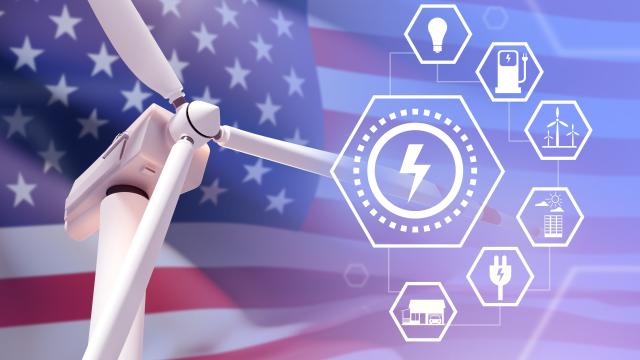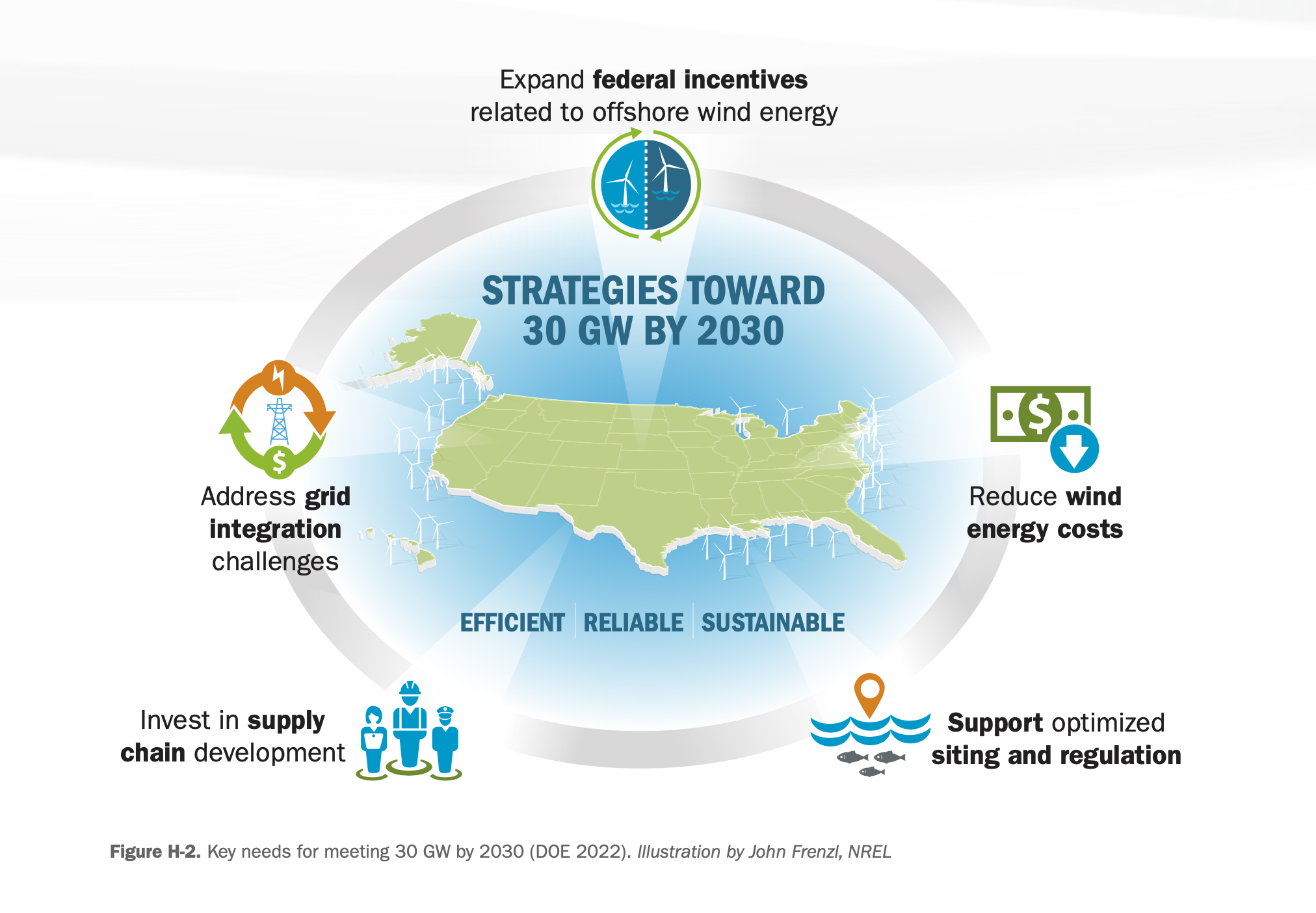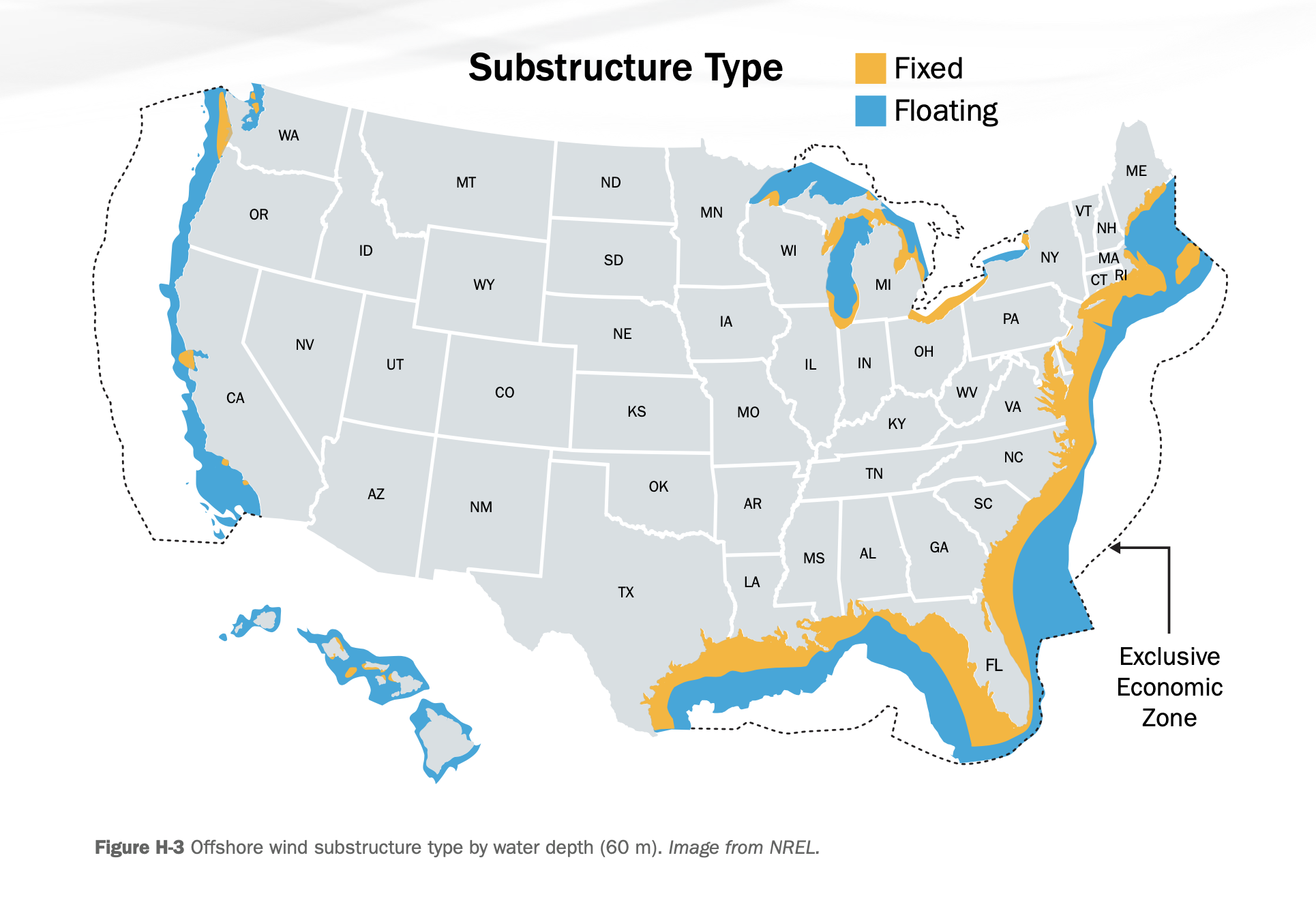
The U.S. seeks to become a leader in the floating wind market, deploying 15 GW of floating wind capacity by 2035. (Source: Shutterstock)
The U.S. Department of Energy’s plan to hit 30 gigawatts (GW) of offshore wind energy capacity by 2030 is asking a lot. The strategy includes lowering costs, optimizing siting and regulation, investing in supply chain development and improving transmission and grid integration.
The strategy, outlined in a report released on March 29, comes as the U.S. aims to tap into its offshore wind potential and become a global leader in floating wind production. Its floating capacity target is 15 GW by 2035.
The U.S. has a long way to go. So far, only seven wind turbines—at a combined 42 megawatts (MW)—are operating offshore in federal waters: Block Island wind farm off Rhode Island and the Coastal Wind pilot off Virginia.
The International Energy Agency’s top offshore wind countries — including China, the U.K., France and the Netherlands — all have capacity ranging from 1 GW to 2.6 GW.
“The transformative potential of offshore wind energy is critical to achieving President Biden’s bold clean energy goals,” said U.S. Energy Secretary Jennifer M. Granholm. “As our Offshore Wind Energy Strategy shows, we’re leveraging all resources across our department to harness this clean and reliable American energy source, which will create tens of thousands of good-paying, union jobs and revitalize coastal communities.”
Efforts to capture some of the more than 4,200 GW of technical offshore wind resource potential comes as the U.S. increasingly turns to renewable and low-carbon energy resources to reduce emissions.
The country’s first commercial-scale offshore wind projects are expected to begin operating this year, part of a pipeline of projects intended to generate about 40 GW.
Commercial operations for Ørsted and Eversource’s jointly owned 12-turbine South Fork Wind offshore New York is scheduled to become operational by year-end 2023. That would be followed by the 62-turbine Vineyard Wind, the nation’s first utility-scale wind project offshore Massachusetts, developed by Copenhagen Infrastructure Partners and Avangrid Renewables.
The U.S. is gearing up for more offshore wind energy leasing rounds, including one proposed for the Gulf of Mexico.
Four-pronged strategy

The Biden administration’s offshore wind goals are sweeping.
In addition to creating more than 77,000 jobs, reaching 30 GW of offshore wind by 2030 could translate into more than $12 billion worth of annual capital, according to the report.
It could also lead to up to 10 new manufacturing plants to produce equipment such as wind turbine nacelles, blades, towers and foundations, plus $11 billion for infrastructure for ports and large installation vessels.
Taking a coordinated approach involving multiple federal agencies, the Energy Department’s strategy comprises four initiatives:
- Now (near-term offshore wind): Lower costs while developing the offshore wind supply chain. Focus is on fixed-bottom offshore wind development, typically at water depths less than 60 m. Goals include reducing cost to $51/megawatt-hour (MWh) by 2030 from $73/MWh in 2021 — as well as optimizing wind turbine designs and strengthening the supply chain by identifying needs such as ports, manufacturing and suppliers, among other areas.
- Forward (floating offshore wind advanced research and development): Become a leader in the floating wind market, deploying 15 GW of floating wind capacity by 2035. Wind developments in deeper water—depths greater than 60 m—are suitable for floating wind technology. “From the total offshore wind resource potential of 4.2 GW, more than 65% is in deep waters, requiring floating platforms,” according to the report.
Here, attention is given to lowering costs: dropping to $45/MWh by 2035 from today’s estimated $150/MWh by making bigger and more efficient wind turbines and developing the domestic supply chain, as well as supporting and funding research.
- Connect (transmission solutions for large-scale offshore wind energy development): Collaboration and long-term transmission planning and phased grid development is “vital to the increased certainty and pace of offshore wind energy development,” the report states. “Transmission solutions must not only be cost-effective, but also reduce environmental and ocean co-use impacts.”
Goals include coordination between federal and state agencies to identify investment priorities for infrastructure; coordinated planning efforts for the design and construction of transmission networks for individual projects; and regional power markets and supporting technology innovation.
- Transform (expanded offshore wind co-generation): Co-generation technologies take the spotlight with this initiative. With widespread electrification and decarbonization in mind, the Energy Department said it will fund R&D activities, conduct demonstration projects and facilitate loans supporting co-generation from offshore wind. Such technologies — referred to as “wind-to-X technologies” — use offshore wind energy to produce another type of energy, such as hydrogen.
The transform initiative includes developing offshore wind energy hubs to evaluate, among other things, the technoeconomic feasibility of such hubs.
“A single offshore wind power plant can deliver a significant amount of energy to coastal load areas, which tend to suffer from transmission congestion and limited siting options for large-scale, land-based renewable energy generation,” the report said.

‘Little speedbump’
Similar to other segments of the energy sector, offshore wind energy developers are working to gain cost competitiveness following 2022’s mix of challenges, including increasing costs, backlogs and higher interest rates.
Speaking during the CERAWeek by S&P Global conference in March, Ørsted Americas CEO David Hardy addressed recent challenges while pointing out how the sector saw a strong levelized cost of energy decline—particularly in the U.K.—until recently.
“When you can put large amounts of offshore wind on the grid at a pretty competitive price, it’s renewable and it creates jobs. There’s quite a bit of momentum around that,” Hardy said. “In the U.S., we were starting behind, of course. We started at a higher number, and we were trending down. We’ve kind of hit a little speedbump, I like to call it, right now with the short-term inflation and supply chain bottlenecks, increasing interest rates.”
The combined effect of macro headwinds may have slowed the trend; however, in the medium and long term, Hardy said the offshore wind power price can be competitive.
It’s about scale and experience, RWE Offshore CEO Sam Eaton added.
“In the U.S. we have seven turbines that are currently spinning. To put it in context, RWE has over 850 spinning across the globe,” Eaton said. “It’s an order of magnitude, multiples orders of magnitude difference in terms of that level of experience.
“With that, you start to drive down not only the cost of production with the scale efficiencies, but also in productivity of installing these projects.”
Eaton encouraged the existing global offshore wind supply chain to expand into the U.S. as the country builds its domestic supply chain.
Preparing for the boom
William Hazelip, president of National Grid Ventures, US Northeast, stressed the importance of planning ahead when it comes to preparing the grid to handle the massive amounts of offshore wind energy expected.
“New York is a great example of this. The system operator there is evaluating proposals to modernize and increase the transmission infrastructure on Long Island to accept more offshore wind,” Hazelip said, adding certainty from targets and policies are also essential for planning transmission infrastructure. “There are two elements: getting the electrons from offshore wind projects to the onshore network and then moving them around in the onshore network because you’re putting electrons into the system where the system is not designed to accept them. A lot of work has to go on there.”
Hazelip sees an opportunity to leverage National Grid’s experience in submarine cable projects, given the company’s work connecting European countries where the offshore wind sector is further advanced.
“There’s a lot of work to do with the supply chain on the transmission side, cables and converters as well,” he said.
Panelists agreed the time has arrived for U.S. offshore wind.
“It’s nice to talk about what’s going to come or what opportunities are ahead of us, etc., but we’re doing it now,” Hardy said. “By the end of this year, we’ll have some real milestones to be proud of and some things to see far offshore, generating power onto the grid in New York.”
Reaching milestones
With one of the most ambitious climate plans in the U.S., New York aims to reduce its greenhouse-gas emissions by 40% by 2030 — and at least 85% by 2050 from 1990 levels.
The state is also targeting a 100% emissions-free grid by 2040, committing to develop 9 GW of offshore wind-produced energy by 2035.
“New York would be served about 30% by offshore wind in that year,” said Doreen Harris, president and CEO of New York State Energy Research & Development Authority (NYSERDA), the state’s clean energy agency. “So, it really is a game changer for our state, not only because of its ability to provide a massive amount of renewable electricity into our load centers in the city and on Long Island, but also because of the economic development opportunities it presents.”
Efforts are already underway to hit New York’s target.
In February, 2022, the New York Bight offshore wind auction offered six leases in federal waters. The leases drew competitive winning bids from six companies totaling nearly $4.4 billion.
The state is now preparing its third offshore wind solicitation. Six offshore wind developers offered more than 100 proposals for eight new projects, NYSERDA said on its website. Awards are expected to be announced in spring 2023.
“We’ll be running multiple RFPs [requests for proposal] this year to really build on the success we have as far,” Harris said. “That’s a huge milestone for us, certainly along with the construction of our first project, which is the victory in its own right for sure.”
Recommended Reading
TPH: Lower 48 to Shed Rigs Through 3Q Before Gas Plays Rebound
2024-03-13 - TPH&Co. analysis shows the Permian Basin will lose rigs near term, but as activity in gassy plays ticks up later this year, the Permian may be headed towards muted activity into 2025.
For Sale, Again: Oily Northern Midland’s HighPeak Energy
2024-03-08 - The E&P is looking to hitch a ride on heated, renewed Permian Basin M&A.
E&P Highlights: Feb. 26, 2024
2024-02-26 - Here’s a roundup of the latest E&P headlines, including interest in some projects changing hands and new contract awards.
Gibson, SOGDC to Develop Oil, Gas Facilities at Industrial Park in Malaysia
2024-02-14 - Sabah Oil & Gas Development Corp. says its collaboration with Gibson Shipbrokers will unlock energy availability for domestic and international markets.
E&P Highlights: Feb. 16, 2024
2024-02-19 - From the mobile offshore production unit arriving at the Nong Yao Field offshore Thailand to approval for the Castorone vessel to resume operations, below is a compilation of the latest headlines in the E&P space.






